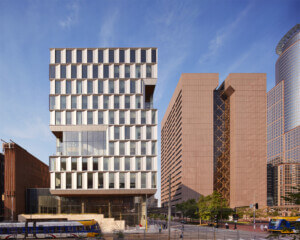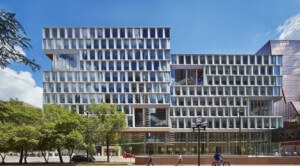[ Editor’s Note: Peter Murray, of the New London Architecture center, together with a dozen architects and planners, is biking from Portland, Oregon to Portland Place in London, studying how cities are responding to the demand for better cycling infrastructure. He reports from the start of his ride. The Architect’s Newspaper is USA media sponsor of the trip and will post periodic updates of these architects on bicycles. ]
We liked Minneapolis—it ended our sojourn in the wilderness of South Dakota, we saw some nice things, met a lot of cool people and the biking there is great!
On our journey plan we had highlighted the fact that the city was host to a bevy of starchitects—Herzog and de Meuron with the 2005 Walker Art Gallery extension, Jean Nouvel with the Guthrie Theater of 2006, and Frank Gehry at the Weisman Museum which opened in 2011.
H&deM’s gallery is their signature decorated rhomboidal shed with aluminum-mesh cladding panels stamped with a pattern of creases, while Nouvel’s is definitely a duck, its cylindrical forms reflecting the concrete silos on adjoining sites and its industrial detailing referencing the mills that once lined the Mississippi River at this point and created the wealth of the 19th century city. A gymnastic cantilever projecting out over the river provides spectacular views to St. Anthony Falls. As he did in London at One New Change and Reina Sofia in Madrid, Nouvel has delivered a popular new public space that enhances the visitor’s experience of the city.
However, our local guides were keener to point out the picturesque ruins of the largest flour mill in the world, destroyed by a flour dust explosion and into which local architects Meyer Scherer and Rockcastle have sensitively inserted a contemporary office building.
But the highlight of our tour was the Christ Church Lutheran designed by Eliel Saarinen in 1948 with an extension by Eero twenty or so years later. The interior is beautifully crafted in brick with a simple curved screen at the altar end flooded with south light.
We had come to Minneapolis to study its cycling infrastructure—and we were impressed. Our group of 13 riders pedalled along the Midtown Greenway, a traffic-free cycle route which runs on a defunct railway line right through the heart of the city, then on to bicycle boulevards—lower-volume, slow speed streets with safe crossings which felt very comfortable to ride in. Bike lanes in the city are comprehensive in the central area and we found it easy to get around.
Last year Bicycling Magazine named Minneapolis America’s “No 1 Bike City,” beating Portland, Oregon, despite the fact that the city experiences ferocious winters and riders have to fit studded tires in icy periods. Nearly four percent of Minneapolis residents bike to work according to Census data—an increase of 33 percent since 2007, and 500 percent since 1980.
Two particularly interesting points, emerged from our conversations—that, like the High Line, the Midtown Greenway is a major generator of new residential development, and, like New York, most of the cycling infrastructure had been put in within the last decade—much quicker than most European cycling cities.
These are just two lessons among the many we will be taking back to London to promote more and better cycling infrastructure in the UK capital.










